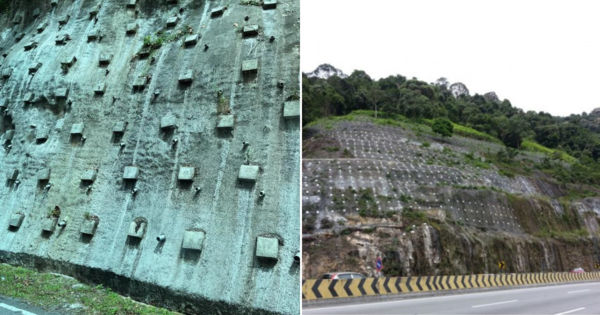Follow us on Instagram, TikTok, and Telegram for the latest stories and breaking news.
If you grew up travelling interstate for vacations every once in awhile, you may have come across these large walls plastered across tall hills by the highway
Often found in particularly hilly areas, we’ve all fantasised climbing these walls with our bare hands at least one time, wondering where these mystic panels would lead.
Image via Averest
But what really is the purpose of these walls that coat these tall mountainous areas?
Recently, one man posed this question to his audience on Reddit, after a trip of Cameron Highlands had him stumped over their actual purpose — and frankly, we were too!
The photo posted by the user at Cameron Highlands on Reddit.
Image via Reddit
After some sleuthing of our own, we found out that these structures are referred to as retaining walls, and are largely used to prevent landslides from occurring
According to the engineering and construction consultancy platform, Reinforced Earth Malaysia, retaining walls are vertical structures used to hold material on one end to keep it from falling or slipping.
The main reason for its build against tall hills around highways is to hold the pressure that exists from the soil, thereby preventing it from collapsing onto the highways.
Covering the soil with these walls also prevent soil erosion from happening during instances of heavy storms or downpour. As for the pipes found on the surface of these walls, they are used to allow water absorbed by the soil flow out as a drainage system.
Multiple versions of these retaining walls exist, which include the standard gravity wall, piling wall (where the wall is cemented deeper into the ground than the standard one, thereby resisting bending from the pressure of soil), and a cantilevel wall (where a horizontal foundation is added to the vertical beam, thereby balancing the pressure from the soil).
Image via AboutCivil.Org
However, the ones commonly seen in Malaysia with square tiles on them are referred to as anchor retaining walls
The square tiles themselves act as a surface to cover the anchors behind them, which are rooted into the soil to provide an additional layer of friction. This enforces the wall’s ability to withstand the pressure of the soil.
Image via Reddit/AboutCivil.Org
Putting our childhood imaginations to rest, rainy seasons in Malaysia may just see much necessity from these nature-preserving walls.



